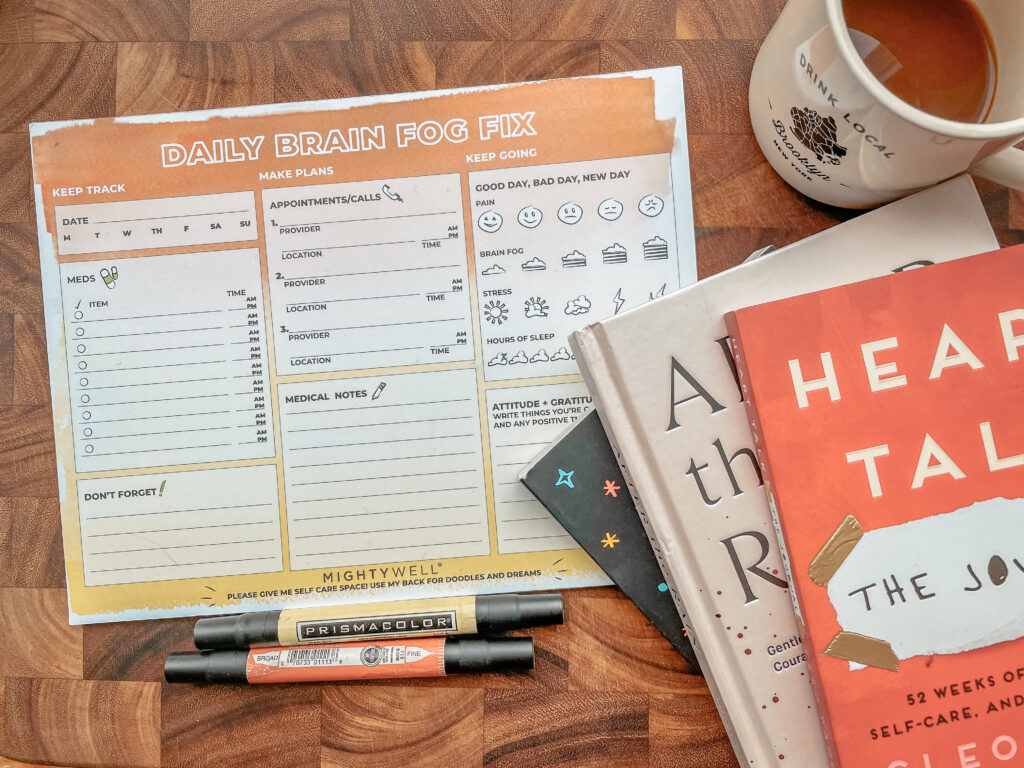Living with chronic pain is exhausting. It’s so much more than just the sensation of pain — it’s the part of your brain that’s constantly distracted, it’s the painsomnia from not being able to get comfortable at night, the grief of giving up activities made impossible, the emotional toll of trying to push through and act normal, and the isolation of existing in such a different space than the people around you.
If you’re reading this, you’ve probably already seen multiple doctors and tried turmeric, acupuncture, and every other remedy suggested to you (unsolicited) by friends and strangers. Perhaps none of this will be new for you, but below you’ll find some tips for chronic pain that have worked for me and many of my Friends in the Fight:
1. Treat all underlying conditions
Yes, this one may seem obvious — find what’s causing the pain and fix it, right? Obviously, it’s rarely that simple. There can be a whole slew of factors that impact your pain, so just treating the one main condition — such as an injury or arthritis — may not fix it entirely. You could also have a (common, yet rarely diagnosed) connective tissue disorder like EDS or HSD. Perhaps your allergies are causing inflammation, which can lead to widespread pain in your muscles and joints.
There may even be an untreated virus or bacterium (such as herpes or Lyme) exacerbating things. Or maybe there’s something weird in your gait or the way you sit at your desk all day that has your spine and pelvis in a funk, which in turn causes pain in several other parts of your body. If any of these seem likely, consider asking your doctor about pursuing some more answers. Treatments for these common pain magnifiers don’t have to be complicated. Your doctor may suggest trying things like:
- Physical therapy (for connective tissue disorders, injuries, and/or alignment issues)
- Antihistamines (for allergies or allergic disorders like MCAS)
- Antiviral or antibiotic medications (if testing finds a virus/bacterium)
- Supports for your shoes or desk chair

2. Keep a pain journal
One way to figure out the underlying triggers of your chronic pain is to keep a pain journal — write down each day what types of pain you experienced, where you experienced them, and the severity. Also write down any potential triggers like stress, strong emotions, foods you ate, sleep, and what you did with your body (exercise, a long car ride, etc). After a few weeks, you (or your provider) may be able to find some patterns. For example, certain foods may cause achy inflammation pain in your muscles and joints. Your pilates routine may be tweaking your neck and exacerbating that nerve pain in your arms. Stress may be causing muscles to tense up, causing headaches and back pain.
If you can identify even a couple of triggers, you can start to chip away at the overall pain level. You can then start to try different remedies, and write down what seems to help or not — try a heating pad on tightened muscles to see if your pain and headaches improve. Or, perhaps an ice pack for inflammation pain. Avoid the foods that set you off. Ask your doctor if they can think of any other remedies that may be specific to the pain patterns you’ve recorded.
Note: keeping a journal like this can feel very empowering, but if you’re not in a good headspace, it can also be emotionally taxing to have to focus on everything that hurts. If you find that your mood worsens after writing in your journal, it may not be a good fit for you right now.
Need a place to track your pain and provide reminders to find gratitude? We created Mighty Well’s BFF planner for this purpose! Check it out here.
3. Diet
As mentioned above, food can be a significant trigger for chronic pain. Histamine — from allergies or just foods naturally high in histamine — can cause inflammation and pain. Some people also react to other ingredients in foods, like gluten, pesticides, preservatives, or salicylates and oxalates. You can use your journal to inform what types of foods trigger your pain, or you can try a generally anti-inflammatory or anti-histamine diet. As conditions like histamine intolerance and mast cell disorders become better understood (and therefore more widely diagnosed), cookbooks and cooking tips are becoming more plentiful. The good news is, these diets don’t have to be super restrictive — often small tweaks to how you cook (such as avoiding leftovers) or adding in antihistamine ingredients (like blueberries and fresh herbs) can make a difference.
Check out our cooking hacks here.
4. Hack the painsomnia cycle
The pain-sleep cycle is, quite frankly, a nightmare. Your doctor says that sleeping more will help reduce your pain. But your pain keeps you up all night. So then you’re exhausted, which in turn causes more pain… I don’t have a quick fix for this one, but it is worth noting how important breaking this cycle can be. There is ample evidence that sleep deprivation increases pain. So if you can possibly find a way to reverse this cycle, you could improve your pain tremendously — as well as your brain fog and overall quality of life!
Some tricks that can help chip away at insomnia are sleep hygiene, practicing meditation or hypno-visualization recordings before bed, and playing around with temperature and pillows to see if you can get your body comfortable enough to make it through the night. Pillows designed for pain or even pregnancy can be very helpful for some types of pain.
5. Reduce stress, improve mental health
As someone who has been told that my pain is all in my head and symptoms were “just anxiety,” I know this topic can feel uncomfortable. In addition to very real underlying conditions (see above), however, there is significant evidence that stress and mental health challenges play a huge role in our pain levels. Not only can our perception of pain be lessened through improving our mental health, but the actual physiology of how we hold ourselves and how much tension is carried in our muscles is closely linked to mood and stress hormones. Any work you can do to reduce stressors in your life or improve your overall mental health will likely make a difference. This could be just examining what causes you stress and making appropriate changes, seeing a therapist, increasing movement/exercise to reduce stress hormone levels, or practicing some form of mindfulness.
Hopefully, something in this list will resonate with you and provide some relief. At the very least, know that you are not alone! The struggle is real, and we are in it with you.
Looking to connect with other chronic pain fighters? Join our Friends in the Fight community!

